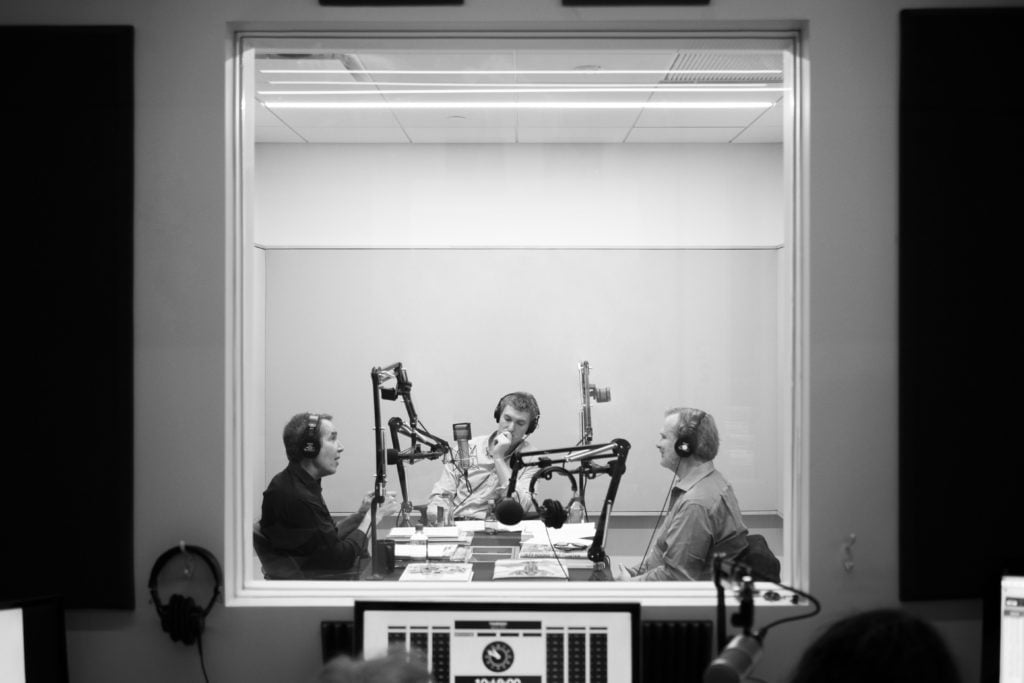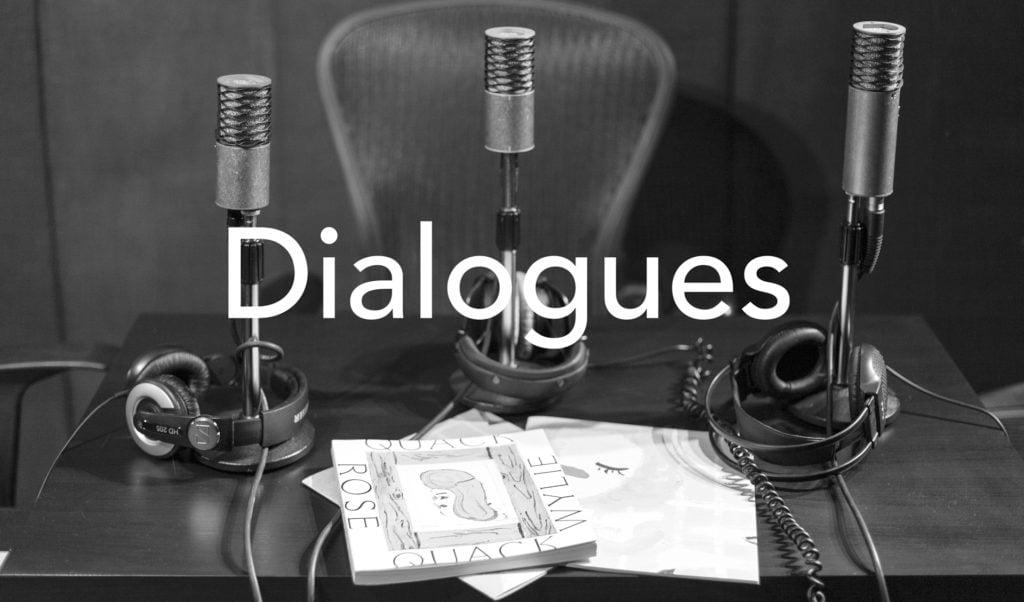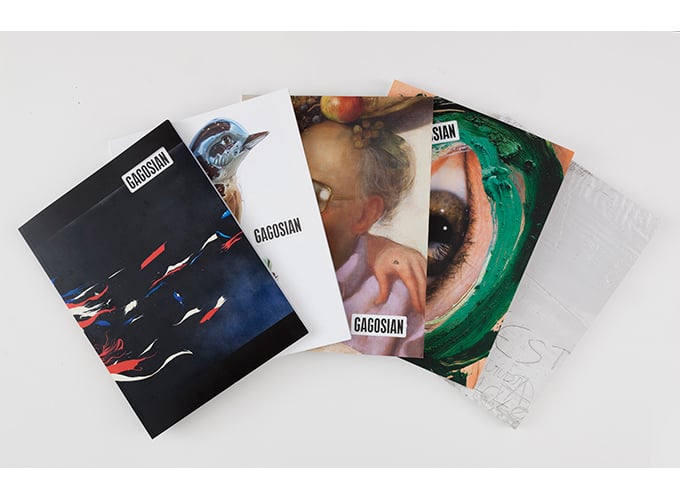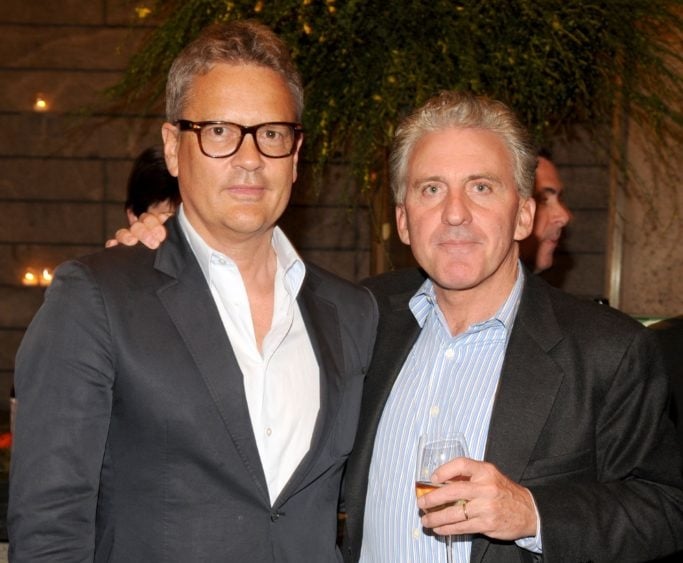Opinion
The Gray Market: Why Mega-Gallery Podcasts and Magazines Mean More Than You Think (and Other Insights)
Our columnist weighs David Zwirner's new podcast and the Gagosian Quarterly alongside Cheim & Read's pivot into "private practice."

Our columnist weighs David Zwirner's new podcast and the Gagosian Quarterly alongside Cheim & Read's pivot into "private practice."

Tim Schneider

Every Monday morning, artnet News brings you The Gray Market. The column decodes important stories from the previous week—and offers unparalleled insight into the inner workings of the art industry in the process.
This week, three stories about the new meaning of “expansion”…

Promo image for David Zwirner’s ‘Dialogues’ podcast. Image courtesy David Zwirner.
On Wednesday, David Zwirner augmented its already substantial media presence by becoming the latest—and largest—gallery to date to launch a podcast. As yours truly relayed the following day, each episode of the neutrally titled Dialogues pairs a David Zwirner artist with a major name from the fields of art, architecture, music, or film to hold forth on the ins and outs of the creative process.
Lucas Zwirner, editorial director of David Zwirner Books, moderates the conversations. The show is available on Zwirner’s website and all the usual podcast-aggregating suspects (Apple, Stitcher, et al).
The inaugural episode of Dialogues teams Jeff Koons with Metropolitan Museum of Art curator Luke Syson (who co-organized the Met Breuer’s current “Like Life” show, among others). Although I’d call the interview surprisingly light and lucid, let’s be real: Like another Bruce Springsteen record or a Joe Biden presidential run, more Jeff Koons is something everyone here already knows whether or not they want in their lives.
However, Syson raises some interesting points, including the paradox that many museums today are catering to the masses by staging shows of Modern masters (see: Monet, Matisse, Picasso) who only ever created for a niche audience during their lifetimes.
Incidentally, this concept is useful in framing what I find to be the most important aspect of Dialogues: its apparent mass-market ambitions. In a statement about the launch, David Zwirner identified the desire to “engage with new audiences” as one driving force behind both the podcast and other digital initiatives wrapped up in the gallery’s ongoing 25th anniversary transmedia campaign.
As I noted in my original piece about Dialogues, other galleries have already beaten Zwirner to the podcast mic, including Sean Kelly (Collect Wisely), Lisson Gallery (On Air), and Postmasters (the members-only Postcast). In terms of its production value and its producer’s place in the commercial hierarchy, though, I might argue that the most direct competitor to Dialogues is In Other Words, the bi-weekly interview podcast that Sotheby’s advisory division, Art Agency, Partners, began producing back in February 2017.
But one of the core differences between Zwirner’s pod and these others comes from behind the mixing boards. Rather than being a completely in-house production, Dialogues credits an outside co-producer: Slate Studios.
Not to be confused with the well-known media vertical Slate (which has a serious podcast presence of its own), Slate Studios bills itself as “New York’s premier full-service content production company, specializing in e-commerce, social content, and brand content for the world’s leading brands.” A quick browse through their selected work page shows that several of those leading brands include high-fashion houses like Prada, Lanvin, Miu Miu, and Givenchy.
At the same time, Slate Studios also serves clients far outside the radius of the runway when it comes to online audio series. They have produced or co-produced branded podcasts with at least four massive corporations hailing from a cross-section of industries: banking titan HSBC (Scaling Global), American auto giant Ford (Life on the Fast Track), instant soup sultan Campbell’s (UnCanned), and big pharma boss Teva (Life Effects).
Based on David Zwirner’s overtures to “new audiences,” the show’s focus on bringing in select pop culture figures, and Slate Studios’s podcast track record with mass-market companies, my personal sense is that the gallery isn’t just positioning Dialogues to tantalize a handful of new collectors. I think they’re likely hoping it can help plant their flag in the cultural mainstream.
Is this aspiration unprecedented? It depends on your thinking. To me, this conversation would be incomplete without mentioning Zwirner’s mega-gallery competitor Hauser & Wirth, which will expand further into the hospitality industry when its founders open a Scottish hotel, the Fife Arms, this winter. (Condé Nast Traveler named it one of the magazine’s 18 hottest hotel openings in 2018.)
I say “expand further” because Hauser & Wirth already operates three well-regarded bars and restaurants in three cities worldwide: the Roth Bar at its 22nd Street gallery in New York, the Roth Bar & Grill at its Somerset space, and Manuela, the destination restaurant inside its Los Angeles complex.
I’ll leave it to readers to make value judgments about the expansionist ventures from both galleries. My point is that they illustrate that the few most commercially elite spaces now have the resources and aspirations to look past incremental art-world growth and aim for the potentially gargantuan upside of mainstream relevance—something the three major Hollywood talent agencies have also been attempting via their own fine art clients.
Whether the vehicles are a slick podcast and print publishing brand or a trendy hotel and restaurant fleet, they’re all leading toward the same new frontier for contemporary art. Buckle up.

Gagosian Quarterly. From left to right: spring 2018 through spring 2017 issues. Courtesy Gagosian
Also on Wednesday, author and blue-chip art authenticator Richard Polsky argued that auction house catalogues and Gagosian’s in-house print publication, the Gagosian Quarterly, have become the “most relevant” magazines in the art industry today. Framed against the backdrop of Interview magazine’s recent mummification, Polsky’s op-ed points out that these new powerhouses of the printed word simply have budgets and resources far beyond the scope of even the most-storied, longest-running mainstays, such as Artforum, Art in America, and ARTnews.
Part of this advantage, he notes, stems from Gagosian Quarterly’s ability “to attract high-profile advertisers from the world of fashion and luxury—just like Interview” in its prime. “What that means,” he continues, “is that luxury advertisers are paying to appear alongside another form of luxury advertising,” and that this capitalist magnetism pulls in the cash that the Quarterly can use to fund as much, or more, legit scholarship than anyone else.
Through the existential crisis he identifies in print media at large, though, Polsky also cracks the door to a larger parallel germane to this discussion. Lavishly produced in-house art glossies aren’t just another consequence of an era where heavyweight auction houses and galleries can vastly outspend flyweight independent magazines. They are also a consequence of an era where the private sector can consistently and vastly outspend the public sector.
Institutions used to play the largest role in enriching art history, and they still do plenty of fine work in that regard. But there is no way that they can consistently commit to the same fat budgets as Christie’s, Sotheby’s, and Gagosian for essays, photography, catalogues, design, etc. And the reality of modern life is that, whether inside or outside the arts, money generally plays an outsize role in shaping the conversation.
It’s not news that federal and state governments have been slashing arts funding in the US and Europe alike for years. And as David Callahan details in The Givers, his exhaustive analysis of big philanthropy in the contemporary age, private donors have been the ones stepping in to ram Publishers Clearing House-size mega-checks into the gaps.
One data point he relays for context: Private philanthropists donated 4,000 gifts of $1 million or more to cultural institutions between 2005 and 2014, headlined by a single gift to the Dallas Museum of Art valued at $400 million. Even if the other 3,999 of those donations were the bare minimum amount to qualify, we’d be talking about a total one-decade haul just short of $4.4 billion.
Remember, apart from individual collectors, heavy-hitting galleries are largely funding many museum exhibitions and their associated catalogues, especially here in the US. So even when the nonprofit world speaks, it’s still often being influenced, if not quite ventriloquist-dummied, by the will of private interests. The show must go on somehow, right?
Nor does the outsize private leverage stop with museum shows or art magazines. Polsky also rightly notes that the sustained media blitz by major galleries now sometimes includes hiring institutional curators to oversee select commercial exhibitions or contribute to their catalogues. Some spaces are even permanently putting luminaries of the written word on staff to oversee ongoing campaigns of in-house content, as when Hauser & Wirth enticed Randy Kennedy away from the New York Times.
Gallery and auction-produced podcasts belong in this conversation, too. Where else would an interested audience have found interviews with museum-level artists in the past besides art magazines, institutional publishers, or academia? Major sellers now have the resources to push out more, and richer, material of this type than any neutral party, especially in new formats with wider reach. And the winner-take-all incentives say that they should, too.
Late in The Givers, Callahan writes the following about the megaphone effect of private wealth on public policy in the US:
Grassroots movements like the Tea Party or Occupy Wall Street can and do spring up to wield strong influence at certain moments, but—on a day-to-day basis—the deck is stacked in favor of those who have the money to amplify their voices. This helps explain why so many Americans have disengaged from civic life. Why bother?
In 2018, this sentiment carries over to much of the art-sales business, as well. From a media standpoint, small galleries and auction houses can no longer go toe-to-toe with the titans. The latter have budgets too robust and, as a result, footprints too gargantuan.
That does not mean less commercially successful sellers’ work is irrelevant. But it does suggest once again that their sustainability depends on building—and maintaining—coalitions interested in reaching the hearts and minds of entirely different demographics than the ones being drawn in by lush publications, podcasts, and exhibitions, no matter how much scholarly merit they may contain. And that’s a solution that money can’t buy.

John Cheim and Howard Read. Image © Patrick McMullen, photo: Clint Spaulding/PatrickMcMullan.com.
Finally this week: Late on Thursday afternoon, Chelsea mainstay Cheim & Read announced that it will close its public program and depart its current space for a new venue uptown, where, as of 2019, it will primarily focus on private resales, sculpture commissions, and special projects. A statement about the move added that the gallery will also “continue to work with artists and estates that have been associated with the gallery throughout its history,” as well as stage “small-scale, focused installations” and show at “select art fairs.”
As with Andrea Rosen last February and McKee Gallery in 2015, the art industry consensus held that Cheim & Read was one of the few, the proud, the brave commercially successful outfits still largely doing things “the right way” (however one defines that phrase). From the people I’ve talked to since the news broke, the gallery’s pivot could hardly feel less ominous if the announcement had been written in the sky by a formation of screeching vampire bats.
As every write-up of this development reinforces, it’s impossible to overlook the fact that Cheim & Read recently lost two major artists—both of whose work they had represented for many years—to even more commercially muscular galleries. Pat Steir went to Lévy Gorvy in 2016, and the Joan Mitchell estate opted for representation with David Zwirner just a few weeks ago.
Now, I think it’s important not to draw too straight a line between those defections and Cheim & Read’s strategic shift. If losing a couple of longtime artists is the only factor in play here, I’ll empty my bank account ordering every reader $214 gold-flecked grilled cheese sandwiches. (Side note: WTF are we doing as a species, really?)
But I think it would be equally naïve to assume the defections were irrelevant, both on a practical level and in terms of auguring the arrival of a newly aggressive set of priorities among artists and their heirs or estates. In-demand artists are exercising their free agency to a greater degree than ever before, and big-name estates have become some of the most sought-after prizes in the gallery sector (with auction houses getting in the game, too).
In my eyes, this frenzy seems to be driven by the very 21st-century notion that what’s best for an artist’s legacy is always to achieve the largest possible audience, the biggest possible prices, and the most possible exposure. It’s collector and commentator Alain Servais’s #GrowOrGo dilemma, only blasting out of studios and estates rather than galleries.
But if that ask becomes the default, then only a small fistful of galleries can legitimately claim to have the answer. And despite having the firepower to sell some multimillion-dollar artworks and, more importantly, an approach that warranted the respect of many of their peers, Cheim & Read was not among those ultra-ambitious few.
This fact might not have necessarily forced the gallery’s co-founders to downshift into “private practice,” as Thursday’s announcement termed it. But as Cheim & Read’s namesakes looked to a future of world-conquering artists and estates, in-house gallery media departments, and art sellers doubling as hoteliers, I wouldn’t be the least bit shocked if they simply decided that, after their 21 years of bespoke success, the game had changed for good—and they were no longer interested in playing by the new rules.
That’s all for this week. ‘Til next time, remember: Money talks, but you can still change the conversation—or at least walk away from it.